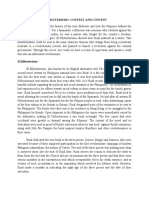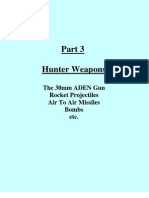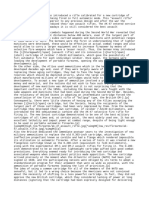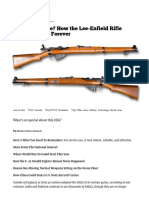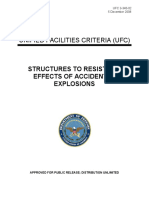40mm Fact Vs Folklore
40mm Fact Vs Folklore
Uploaded by
Nattapong DanaisawasCopyright:
Available Formats
40mm Fact Vs Folklore
40mm Fact Vs Folklore
Uploaded by
Nattapong DanaisawasOriginal Title
Copyright
Available Formats
Share this document
Did you find this document useful?
Is this content inappropriate?
Copyright:
Available Formats
40mm Fact Vs Folklore
40mm Fact Vs Folklore
Uploaded by
Nattapong DanaisawasCopyright:
Available Formats
Fact vs.
Folklore; the 40mm “L-60” Bofors Gun
By CMSgt Bill Walter, USAF (Ret.)
The 40mm M2A1 gun currently used on the AC-130 machined steel and alloy parts. They also discovered the
Gunship has Swedish roots dating back to the 1930s. gun was built in the old world craftsman tradition of
Originally invented by Bofors Ordnance, Karlskoga, machining parts slightly oversized and using “file to fit
Sweden as the Model 1934, you could say the gun was at assembly” production techniques. Unfortunately,
truly in the right place at the right time at the beginning hand-fitted parts are very problematic for mass
of WWII. The outbreak of hostilities caught the United production manufacturing methods. The first US
States and Great Britain woefully unequipped with company contracted to build the naval version of the
Bofors gun was York Safe & Lock, York, Pennsylvania.
A contract was formally awarded in April of 1941 even
though work began months earlier using “acquired”
Dutch machine drawings. The first problem encountered
was conversion of the Dutch drawings to American
measurements which resulted in “uniquely dimensioned
parts” compared to the original Bofors gun. As
production began, many technical problems were
encountered resulting in slow progress and low
production quantities. The final gun produced by York
Safe & Lock was functionally identical, but
dimensionally unique in comparison with the original
Swedish gun. These guns served on US Navy ships
throughout WWII.
Coinciding with the Navy gun production effort, the US
Army ran a similar unlicensed 40mm gun acquisition
program for the Army version of the Bofors gun. To
meet projected demands, The Army decided to award a
contract to Chrysler Corporation. Chrysler was very
experienced in mass production methods in their
automotive assembly plants, but building guns differs
greatly from building automobiles. Their first problem
suitable air defense guns. Both countries needed followed the experience of York Safe & Lock. Chrysler
guns…many guns, and quickly. Trouble is there was dedicated a great deal of work to convert drawings
nothing “quick” about building the Bofors gun. A single acquired from Great Britain to American measurements.
gun took Bofors 450 man-hours to produce and they As the program progressed, Chrysler engineers decided
could only produce limited quantities of guns per month. simplification of the complex functional design was not
The US and Great Britain needed many thousands of possible. As such, Chrysler re-designed components and
guns. To meet heavy production demands, the US sought materials only enough to enable mass production within
a license to build the gun themselves, but was the capability of their production lines, tooling and
unsuccessful in establishing a contract with Bofors. foundry. Chrysler was confident they could meet
Undeterred and desperate for guns, the US decided to production goals but experienced extreme difficulties
produce unlicensed copies of the gun. After obtaining standing up a production line. It took Chrysler one year
metric drawings from the Dutch government, Navy to produce their first unique version of the Bofors gun.
engineers discovered the Swedish gun was a highly Within a few months of full production, Chrysler was
complex mechanical masterpiece of more than 1500 manufacturing a complete gun from start to finish in ten
man-hours. This was an amazing feat that would be 40mm Guns on the AC-130
difficult to do today even with modern machinery.
The L-60 40mm gun was first considered for AC-130
Eventually, Chrysler took the lead of all 40mm gun
use in 1969 during the Vietnam War. It was meant to
production and standardized both Army and Navy guns.
increase stand-off distance and improve overall combat
The demand for guns at the production height of WWII
effectiveness. Contrary to popular belief, the original
was so great it surpassed Chrysler’s capacity as well. To
AC-130A 40mm guns used in flight testing were Army
meet the wartime demand, Pontiac was awarded a
M1 guns not a Navy Mk-series guns pulled from ships.
contract to build 40mm guns. Pontiac built both M1 and
These guns were heavy and cumbersome, but they
M2 (dual) guns for the US Army. When it was all said
existed…and looked like they could fill a rapid combat
and done, production of all versions of the US 40mm
capabilities need. Mounting the 1000 lb. gun to an
gun exceeded 60,000 until production ceased in the
AC-130 was not easy. Aeronautical engineers designed
1950s. These guns served US and allied nations well
an incredibly robust gun mount from plate steel, placed a
into the early 1990s. Today, the AFSOC AC-130 fleet is
gun in it and ground tested the assembly. Blast
the sole remaining user of the gun in the entire DoD and
overpressure problems were encountered initially but
only one of a handful of users of the 40mm “L-60”
solved with extensive study and analysis. When ready
Bofors gun remaining in the world.
Differences of Navy and Army Guns
for production, engineers selected the M2A1 gun from
the US Army M42A1 “Duster” tracked anti-aircraft
system. Duster used “mirror imaged” guns bolted
together with left and right hand controls. The pair was
functionally identical but was loaded and operated from
opposite sides of the Duster turret. Mounting the two
guns bolted together was not practical or desirable for
AC-130 use, so right hand and left hand guns were
separated and modified for individual mounts. The first
Naval guns carried the traditional Navy “Mk” (Mark) M2A1 (modified) guns were installed on AC-130A
designation while Army guns carried the “M” (Model) Gunships under the “Surprise Package” program. These
designation. The principal differences between Navy guns served on AC-130A aircraft until aircraft retirement
and Army guns were the location of the trunions in the mid 1990s when all the left hand guns were
(elevation pivots), the barrel and the breech casing overhauled for use on the AC-130U. These original
design. Naval Mk-1 and Mk-2 guns used “water AC-130A guns, mostly manufactured in the 1950s,
jacketed” barrels and trunions near the center of gravity continue to serve AC-130U crews in Afghanistan today.
of the elevating mass. Trunions of all Army models and
the Naval Mk-5 (submarine/ patrol craft model) were
located well aft of the center of gravity to lower mount
profile and all guns were equipped with air-cooled
barrels.
Back to the Future? remove old paint and corrosion. Once cleaned and
inspected, the breech casings were modified and
During 2002, as Operation Enduring Freedom reached
machined in AFRL’s Model Shop to original AC-130
full swing, the Air Staff realized there were not enough
“Surprise Package” drawing specifications. Once all
AC-130 gunships to meet demands. In response, they
modifications were complete, the unpainted guns were
initiated what was called the “Plus Four” program to
taken to an AFRL range at Eglin for test firing. Using
rapidly build four additional AC-130U gunships. By
an original AC-130A gun mount and a firing rod
then, the once prolific M42A1 Duster system had long
borrowed from the “The First Lady” (AC-130A
since been retired. There were no guns available in the
53-3129) at the USAF Armament Museum. Both guns
supply system for the “Plus Four” program. It appeared
test fired perfectly in both single and rapid fire modes. A
all viable sources for guns were depleted. An attempt
subsequent trip to Nellis AFB netted three more guns.
was made to award a contract to produce newly
These were shipped, inspected and modified to the same
manufactured guns, but production and financial reality
standard as the first two.
of building a “unique-new-old-gun” was deemed
unrealistic and unaffordable. After testing was completed, the guns were
disassembled, re-inspected, painted flat black, re-
Recognizing the problem, several AC-130 gunners
assembled and turned into the supply system. Since
stepped forward to assist the old fashioned
these guns were manufactured by the same company at
way…scrounging. In the past, they had seen many
the same time that current AC-130 guns were originally
M42A1 Duster systems sitting on target ranges on Nellis
built, they are matching in all respects with the current
Air Force Base. The guns on the M42A1s appeared to be
fleet of guns. The entire project took about six months
in very good condition and “ripe for the picking”. With
to complete at a cost of $130K. The real cost of these
this bit of intelligence, staff officers from the HQ
guns if procured today exceeds $8.6M. A great level of
AFSOC Gunship Requirements Branch contacted Nellis
credit goes to the “out of the box” thinkers whose ideas
Range Operations personnel to arrange a visit to inspect
and hard-work filled a critical requirement for a fraction
the guns. After approval, several gun technicians and a
of projected cost, delivering guns at least four years
program analyst quickly arranged a trip to Nellis. The
sooner than planned.
guns were inspected, found to be in good condition and
two dual guns were successfully recovered.
40mm Gun Facts
The guns were then shipped to Eglin Air Force Base for Not a single 40mm gun used by the US was actually
detailed inspection and modifications. Air Force built by Bofors in Sweden.
Research Lab (AFRL) technicians disassembled and
inspected the guns and components inspected. They Commonly called the Bofors “L-60”, our gun is actually
found that with few exceptions, most parts were in an L-56 (caliber x 56 = barrel length).
serviceable condition. Critical parts were metal About the Author: Chief Walter served as AC-130H/U
particulate inspected and re-finished with a zinc Aerial Gunner for 26 years. He currently works at HQ
phosphate finish. Breech casings were water-blasted to AFSOC, Gunship Requirements, as a Program Analyst.
You might also like
- Wear of The Army Green Service UniformDocument17 pagesWear of The Army Green Service UniformJeff LaBarre100% (1)
- Konica-Minolta Bizhub c3100pDocument319 pagesKonica-Minolta Bizhub c3100pwilliam lozadaNo ratings yet
- Chapter 13 - El Filibusterismo: Context and ContentDocument3 pagesChapter 13 - El Filibusterismo: Context and ContentAnne Xx0% (1)
- Vol 2. Part 3 - Hunter Weapons 103111Document94 pagesVol 2. Part 3 - Hunter Weapons 103111David Griffin86% (7)
- Bofors 40 MM: Navigation Search Improve This Article Reliable Sources Challenged RemovedDocument17 pagesBofors 40 MM: Navigation Search Improve This Article Reliable Sources Challenged RemovedNazir ShamsNo ratings yet
- M1911 PistolDocument14 pagesM1911 Pistolblowmeasshole19110% (1)
- 40 MM Bofors HistoryDocument53 pages40 MM Bofors HistorydunmunroNo ratings yet
- US Air ForceDocument76 pagesUS Air ForceAbdullah OmerNo ratings yet
- Tactical Knives Combat KnivesDocument2 pagesTactical Knives Combat KnivesGurpreet Singh100% (1)
- The Role of Science and Industry Small Arms and Ammunition WW 2 Civil Vol 5 ch15Document10 pagesThe Role of Science and Industry Small Arms and Ammunition WW 2 Civil Vol 5 ch15werdna67No ratings yet
- 5.56mm - DuPont, Olin and ... The Great Propellant ControversyDocument5 pages5.56mm - DuPont, Olin and ... The Great Propellant Controversyblowmeasshole1911No ratings yet
- The Bombsight War Norden Vs SperryDocument6 pagesThe Bombsight War Norden Vs Sperrymarco100% (1)
- SpiwDocument6 pagesSpiwsmashzionism12345No ratings yet
- SpiwDocument5 pagesSpiwsmashzionism12345No ratings yet
- The Bombsight War - Norden Vs SperryDocument6 pagesThe Bombsight War - Norden Vs SperryPaul DupontNo ratings yet
- The 5.56 X 45mm 1957 - 1962 - A Chronology of Development - by Daniel WattersDocument35 pagesThe 5.56 X 45mm 1957 - 1962 - A Chronology of Development - by Daniel Wattersblowmeasshole1911No ratings yet
- History of The Johnson RifleDocument16 pagesHistory of The Johnson Rifleblowmeasshole1911No ratings yet
- Amm 20mm Cannon CartridgesDocument7 pagesAmm 20mm Cannon Cartridgesenrico50% (2)
- Bofors Automatic CannonDocument9 pagesBofors Automatic CannonRahmad MorangNo ratings yet
- Kalashnikov Assault RiflesDocument4 pagesKalashnikov Assault RiflesTimia TalashekNo ratings yet
- Origin of A Primer BallisticDocument6 pagesOrigin of A Primer BallisticWilbert ReyesNo ratings yet
- Artillery of The Red Army Part IIIDocument8 pagesArtillery of The Red Army Part IIIClaus Jørgen PetersenNo ratings yet
- British Enfield Rifles - NRA - 2004Document28 pagesBritish Enfield Rifles - NRA - 2004giuliva67100% (11)
- History: Accuracy InternationalDocument12 pagesHistory: Accuracy InternationalH2AKNo ratings yet
- Commando, Fleetwing BT 12, Douglas A 20 Havoc,: JL Mcclellan: P51 Draft P 1 of 32Document32 pagesCommando, Fleetwing BT 12, Douglas A 20 Havoc,: JL Mcclellan: P51 Draft P 1 of 32Kliment VoroshilovNo ratings yet
- Gun Digest Guide to the Modern AK: Gear, Accessories & Upgrades for the AK-47 and Its VariantsFrom EverandGun Digest Guide to the Modern AK: Gear, Accessories & Upgrades for the AK-47 and Its VariantsRating: 5 out of 5 stars5/5 (1)
- Forgotten Handguns of The U.S. MilitaryDocument5 pagesForgotten Handguns of The U.S. MilitaryRobReedNo ratings yet
- Weapons of WW1 TaskDocument5 pagesWeapons of WW1 TaskPaul ChoiNo ratings yet
- Field Artillery Journal - May 1926Document116 pagesField Artillery Journal - May 1926CAP History Library100% (1)
- Seminarski o TenkovimaDocument10 pagesSeminarski o TenkovimaAndrija JestrovicNo ratings yet
- Best Handguns MadeDocument10 pagesBest Handguns Madejpes100% (2)
- World War 1 1Document6 pagesWorld War 1 1api-254472149No ratings yet
- M-24 Sniper Weapon SystemDocument14 pagesM-24 Sniper Weapon Systemمحمد على100% (1)
- 40mm Bofors AAA GunDocument2 pages40mm Bofors AAA GunMoulin Kubis100% (3)
- US Army AH-1 Cobra Units in VietnamFrom EverandUS Army AH-1 Cobra Units in VietnamRating: 3.5 out of 5 stars3.5/5 (2)
- Maxim GunDocument2 pagesMaxim Gunre2umbrellacorpNo ratings yet
- HOW IT WORKS: The Caliber .50. M2 Browning Machine Gun: The Caliber .50 M2 Browning Machine GunFrom EverandHOW IT WORKS: The Caliber .50. M2 Browning Machine Gun: The Caliber .50 M2 Browning Machine GunNo ratings yet
- Mauser Oberndorf PDFDocument15 pagesMauser Oberndorf PDFgglocksterNo ratings yet
- US 30.06 Caliber Military WeaponsDocument14 pagesUS 30.06 Caliber Military WeaponsErich Eshelman100% (1)
- Nuevo Documento de TextoDocument3 pagesNuevo Documento de TextoyyyNo ratings yet
- Collector's Manual For Cartridges PDFDocument192 pagesCollector's Manual For Cartridges PDFEnriquenf100% (4)
- The AKDocument6 pagesThe AKjeffreycalhounNo ratings yet
- Fallschirmjagergewehr 42 (FG42) Light Machine Gun (NAZI)Document7 pagesFallschirmjagergewehr 42 (FG42) Light Machine Gun (NAZI)blowmeasshole1911No ratings yet
- Battle RiflesDocument9 pagesBattle RiflesYorgos KordoniasNo ratings yet
- Albatros D.III: Johannisthal, OAW, and Oeffag variantsFrom EverandAlbatros D.III: Johannisthal, OAW, and Oeffag variantsRating: 4 out of 5 stars4/5 (2)
- Owen Gun Nomination - Australian Institute of EngineersDocument47 pagesOwen Gun Nomination - Australian Institute of Engineersjon fadareNo ratings yet
- Assault Rifles IndexDocument254 pagesAssault Rifles IndexGeorge Bailey67% (9)
- W m1 CarbineDocument18 pagesW m1 CarbineBruce Lee Hutfless100% (1)
- Pedersen RifleDocument14 pagesPedersen Rifleblowmeasshole1911100% (1)
- SAFN 49 Venezuala DevelopmentDocument3 pagesSAFN 49 Venezuala Developmentp317No ratings yet
- Marquages, Codes Anglais Sur Les Fusils Lee EnfieldDocument41 pagesMarquages, Codes Anglais Sur Les Fusils Lee EnfieldClaude CaiafaNo ratings yet
- Episode 1 2 3firearmsDocument2 pagesEpisode 1 2 3firearmsMoreno Plaza RodolfoNo ratings yet
- Civil War Ironclad Ships: ModelingDocument170 pagesCivil War Ironclad Ships: Modelingjns1606100% (1)
- John Browning's Automatic RifleDocument6 pagesJohn Browning's Automatic Rifleblowmeasshole1911100% (2)
- I9I8: Browning Automatic RifleDocument18 pagesI9I8: Browning Automatic RifleJustCallMe_ALNo ratings yet
- Assault Rifles and Their AmmunitionDocument18 pagesAssault Rifles and Their AmmunitionLaurence100% (1)
- TAC AIR Article - WpsDocument15 pagesTAC AIR Article - WpsPeter McGloneNo ratings yet
- CC Gear Chapter 3Document11 pagesCC Gear Chapter 3seafire47No ratings yet
- Ak47 Vs m16Document10 pagesAk47 Vs m16Ejor Somto100% (1)
- How The Enfield Rifle Changed History ForeverDocument7 pagesHow The Enfield Rifle Changed History ForeverGerald McGrath100% (1)
- 1 1946 Storm of EaglesDocument40 pages1 1946 Storm of EaglesMatthew BiggsNo ratings yet
- Peace Building Toolkit Lesson 2 - 8Document6 pagesPeace Building Toolkit Lesson 2 - 8Rahma Ben KhalifaNo ratings yet
- Name: Cathyleen B. Clarido Bsed Ss 4 Name of Student: Date: Year Level/ Course: ScoreDocument8 pagesName: Cathyleen B. Clarido Bsed Ss 4 Name of Student: Date: Year Level/ Course: ScoreCathyleenNo ratings yet
- Allied Military Gazette 1948Document5 pagesAllied Military Gazette 1948Branislav O. PopovicNo ratings yet
- The Cry of Pugadlawin/Balintawak A Detailed OutlineDocument7 pagesThe Cry of Pugadlawin/Balintawak A Detailed OutlineVan Frederick PortugalNo ratings yet
- GEMS Inside For The Corporate 1702831443Document97 pagesGEMS Inside For The Corporate 1702831443Kady YadavNo ratings yet
- DopeDocument4 pagesDopeKeith Jhencell AranezNo ratings yet
- Ufc 3 340 02Document1,943 pagesUfc 3 340 02mirko huaranccaNo ratings yet
- Annex BDocument251 pagesAnnex BJayford RodriguezNo ratings yet
- Central African Republic Small ArmsDocument186 pagesCentral African Republic Small ArmsSolomon S. PondemiraNo ratings yet
- 1 IntroDocument9 pages1 Intronnabue.maxwellNo ratings yet
- President Scholarship For Al Students 2022 2024 TamilDocument1 pagePresident Scholarship For Al Students 2022 2024 TamilSadhurshikaNo ratings yet
- How Far Was Perkin Warbeck's Challenge Responsible For HVII's Insecurity?Document2 pagesHow Far Was Perkin Warbeck's Challenge Responsible For HVII's Insecurity?oli.dulkoNo ratings yet
- 1 STR13 R 1 The Art of War Sun ZiDocument22 pages1 STR13 R 1 The Art of War Sun Ziindra lessy100% (1)
- Fyp Documentary Review Spring 2020 8Document5 pagesFyp Documentary Review Spring 2020 8Marlita HardiyantiNo ratings yet
- Planificación NDT MDE 2021Document23 pagesPlanificación NDT MDE 2021bernardoNo ratings yet
- AtB Documentation.19 - 8 (WIP)Document8 pagesAtB Documentation.19 - 8 (WIP)bewotey862No ratings yet
- Recommissioning of USS New JerseyDocument52 pagesRecommissioning of USS New JerseyManfredi NotarangeloNo ratings yet
- Lockheed-Martin 2021Document132 pagesLockheed-Martin 2021badboyz554547No ratings yet
- AH-1 CobraDocument9 pagesAH-1 Cobratsibarev61No ratings yet
- Colomina - Smithson - Friends of The Future, A Conversation With Peter SmithsonDocument29 pagesColomina - Smithson - Friends of The Future, A Conversation With Peter Smithsonlayla.j.arqNo ratings yet
- Laser and Directed Energy Weapons Within International Humanitarian LawDocument46 pagesLaser and Directed Energy Weapons Within International Humanitarian LawChenyang DengNo ratings yet
- China Pakistan Economic Cooridor Overview:: CPEC Vision & MissionDocument3 pagesChina Pakistan Economic Cooridor Overview:: CPEC Vision & Missionlaiba emanNo ratings yet
- Working in Socially Dervise EnvironmentDocument12 pagesWorking in Socially Dervise EnvironmentJEAN DE DIEU MUVARANo ratings yet
- Intercorp 3.0Document51 pagesIntercorp 3.0Alif AnasNo ratings yet
- Mitre Att&Ck Study OverviewDocument12 pagesMitre Att&Ck Study Overviewvomawew647100% (1)
- A V Hmoëgdr ÑDMV Í MVRB X (BV-D (MVM Mo ÑWMZ: Mm¡Ï M Dym©NzDocument1 pageA V Hmoëgdr ÑDMV Í MVRB X (BV-D (MVM Mo ÑWMZ: Mm¡Ï M Dym©Nzuday xeroxNo ratings yet


